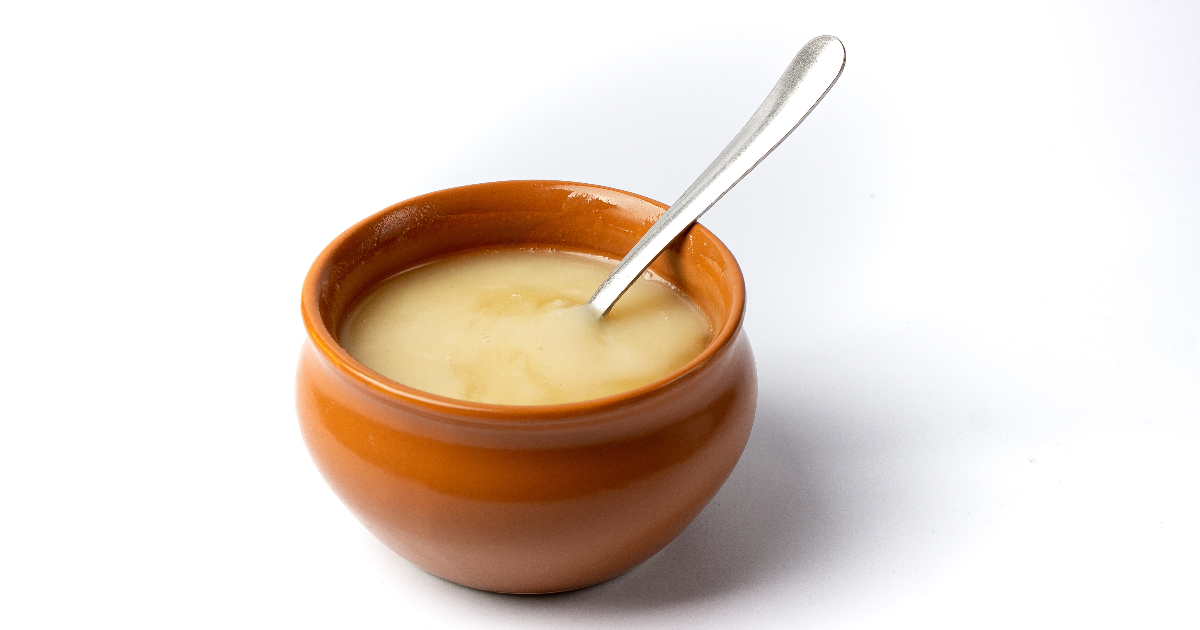Butter, cheese, and ghee are all popular dairy products used commonly in cooking and baking.

While they share some similarities since they all originate from milk, they have distinct differences when it comes to their nutritional profiles, production methods, flavors, textures, and best uses.
What is Butter?
Butter is a dairy product made by churning cream or milk to separate the solid fats from the buttermilk. Commercial butter is made by pasteurizing cream, cooling it, and then churning it until the fat globules stick together to form butter.
Butter contains at least 80% milk fat, with the remainder being water and milk solids. Its semi-solid state, creamy texture, and rich flavor have made butter a beloved ingredient around the world for baking, cooking, and spreading.
Some key attributes of butter include:
- Semisolid at room temperature
- Contains 82-86% milk fat
- Rich in vitamins A, D, E, and K
- Sweet, creamy flavor
- Low smoke point of 300-350°F
- Not suitable for those with lactose intolerance
Key Takeaway: Butter is a semi-solid dairy product made by churning cream, consisting of 80% or more milk fat, and known for its sweet flavor and creamy richness.
What is Cheese?
Cheese is a fermented dairy product made by coagulating milk proteins, separating curds from whey, and letting the curds ripen. The ripening process is what defines the flavor and texture characteristics of different cheese varieties.
Cheese curds are drained, salted, shaped into forms, and aged. As cheese ages, moisture evaporates, and flavors and textures intensify. Different strains of bacteria and molds are used in cheesemaking to develop hundreds of distinct cheese varieties around the globe.
Some key qualities of cheese include:
- Wide range of flavors, aromas, and textures
- 25-35% water content
- 25-35% protein
- 20-40% fat
- High in calcium and B vitamins
- Contains lactose, unless aged over a year
- Raw or pasteurized milk can be used
- Can be eaten fresh or aged for months or years
Key Takeaway: Cheese is made by coagulating milk proteins, aging curds to develop flavors/textures, and contains a wide range of fat, protein, and moisture levels depending on variety.
What is Ghee?
Ghee is clarified butter, prepared by simmering butter and removing the milk solids and water. Removing the milk solids prevents moisture from evaporating when ghee is heated, resulting in a higher smoke point. Ghee originated in ancient India and remains a staple in South Asian cuisine.
To make ghee, butter is melted and allowed to simmer for an extended period. As it simmers, water evaporates, and milk proteins sink to the bottom where they caramelize into a crispy residue. Once cooled, the residue is strained out, leaving pure butterfat.
Common attributes of ghee include:
- 99-99.5% butterfat
- Nutty, caramelized flavor from browned milk solids
- Very high 485°F smoke point
- Long 1-2 year shelf life unrefrigerated
- Lactose-free; contains almost no casein or whey
- Rich source of butyrate and antioxidants
- Clarified state allows versatility in cooking
Key Takeaway: Ghee is clarified butter with milk proteins removed, known for its high smoke point, nutty caramelized flavor, and shelf stability.
Butter vs Cheese vs Ghee: How Do They Compare?
Butter, cheese, and ghee all provide slightly different nutritional and culinary attributes. Here’s an overview comparing the key differences between the three:
Nutrition
- Calories: Butter and ghee have almost identical calorie counts. Cheese has a wide range depending on variety. Full-fat cheeses can be as high as butter and ghee.
- Fat Content: Butter and ghee contain over 80% fat calories. Cheese ranges from 20-40% fat.
- Protein Content: Cheese often contains 25-35% protein. Butter and ghee contain negligible protein.
- Lactose/Casein Content: Ghee is lactose and casein free. Butter contains small amounts. Cheese contains both unless fully aged.
Production
- Butter is churned from fresh cream.
- Cheese uses enzymes or acids to separate curds from whey. Curds are salted, shaped, and aged.
- Ghee is simmered butter with milk proteins caramelized and strained out.
Flavor and Texture
- Butter is rich, creamy, and subtly sweet.
- Cheese ranges from soft to hard, mild to pungent.
- Ghee has a nutty, toasted aroma and savory taste.
Best Uses
- Butter: spreads, baking
- Cheese: raw, baked, melted, grilling
- Ghee: high-heat cooking, frying and sautéing
Key Takeaway: While similar as dairy products, butter, cheese and ghee differ significantly in nutritional attributes, how they are made, flavors, and ideal culinary applications.
Making and Storing Butter, Cheese, and Ghee
All three products require proper storage conditions after being made for food safety and preserving freshness. Here is an overview:
Making and Storing Butter
Butter can be easily made at home by shaking, churning or beating cream until it separates into butterfat clumps and liquid buttermilk. Without proper cooling, homemade butter remains soft and spreadable for only 2-3 days before going rancid. For storage up to a few weeks, form a log shape, wrap tightly in parchment and plastic wrap, and refrigerate.
Commercially packaged butter can maintain quality for 1-3 months refrigerated. For maximum freshness, butter should be used within 1-2 weeks of opening. Signs of spoilage include sour smell, watery consistency, visible mold, or bitterness. Discard spoiled butter.
Making and Storing Cheese
Hundreds of cheese varieties stem from subtle differences in ingredients, cultures, aging conditions, and handling. The basic process involves acidifying milk to separate curds, draining whey, salting and shaping curds, and aging. Aging duration (2 months to 10+ years) and conditions (bacteria, humidity, temperature) affect the sharpness, texture and shelf life.
Cheese requires refrigeration once cut, with firm types lasting weeks to months, and soft cheeses 1-2 weeks. Signs of spoiled cheese include mold, undesired crystallization, unpleasant aromas, and abnormal textures. Discard moldy or questionable cheese.
Making and Storing Ghee
Simmering butter slowly for an extended time separates pure butterfat and caramelized milk solids. Straining leaves clarified ghee. As all moisture evaporates in producing ghee, it keeps without refrigeration for up to a year when stored in an airtight container. No need to discard if solidified; simply liquify again gently before use. Ghee lasts several months refrigerated but shouldn’t be frozen, as this can destabilize the fat structure over time.
Best Uses for Butter vs Cheese vs Ghee
Butter, cheese, and ghee each shine in different applications.
When to Choose Butter
Butter is the go-to choice to mix into dough or batter for enhanced richness, tenderness and flavor. The milk solids also provide more structure when creaming sugar and butter together. Butter adds a gourmet touch when finishing meats and vegetables. Due to its low smoke point, it can burn quickly at higher temperatures. Refrigerate and use within 1-2 weeks for optimal freshness.
When to Choose Cheese
Cheese adds concentrated flavor and texture whenever milk would otherwise be used – mixed into pasta, eggs, vegetables, sandwiches, sauces and soups. Melting softens textures. Hard grating cheese tops pizzas, salads, pastas and bakes into an irresistible crust. Crumble over casseroles just before serving so cheeses don’t overheat and separate. Let flavors continue developing at room temperature.
When to Choose Ghee
With its smoke point over 450°F, ghee allows frying and sautéing at high heats. Nutty aroma infuses into stir fries. Coat vegetables to roast without burning. Mix into rice and lentils. Replace oil or butter in most recipes. Ghee keeps for months without refrigeration. Its versatility and lactose-free properties make ghee suitable for restricted diets when butter or cheese wouldn’t fit.
Key Takeaway: Butter is best used unheated in dough and batters; cheese adds flavor whenever milk would be used; ghee suits high-heat cooking.
Health Impact: Is Butter, Cheese or Ghee Better For You?
With butter, cheese, and ghee all being high in total and saturated fats, health professionals often recommend limiting intake to small servings. Those with high cholesterol or heart disease risk may need to monitor consumption more closely.
However, emerging research shows that the saturated fat in dairy may not directly cause poor heart health. Rather, living optimally overall – staying active, managing weight, eating more plants and less processed foods – seems more predictive of cardiovascular disease than dairy fat intake alone.
Still, each dairy type affects individuals differently. Some experience inflammation, congestion or gain weight with cheese and butter, while ghee with its removed milk proteins offers easier digestion. Grass-fed ghee in modest amounts may benefit cholesterol numbers.
For optimal health, emphasize whole foods like vegetables, fruits and whole grains as your dietary foundation. Carefully monitor individual reactions if including regular butter, cheese or ghee.
FAQs
Is ghee better for you than butter?
Ghee offers a lactose-free alternative for those sensitive to dairy. With its high smoke point and longer shelf life, ghee suits certain cooking methods better. However, butter provides a sweeter, richer flavor for baking and finishing dishes. Both deliver a hefty dose of saturated fat calories, so enjoy in moderation.
What’s the difference between cheese and ghee?
Cheese and ghee are distinctly different dairy products. Cheese is created by separating milk curds from whey, then aging to develop flavor. Ghee is produced by clarifying butter into pure butterfat. While cheese often melts well, ghee allows higher-temperature cooking. Both should be limited for those managing weight or cholesterol.
Is it OK to cook with ghee everyday?
Using ghee regularly is fine unless you are closely managing blood lipids or weight. With its high smoke point, ghee allows flavorful high-heat cooking. Still, ghee delivers concentrated saturated fat calories. Limit daily intake to 1-2 teaspoons. Emphasize whole, plant foods as your dietary foundation.
Conclusion
Butter, cheese, and ghee each impart their own special qualities to recipes through distinct nutritional profiles, textures, flavors, and performance at different temperatures.
Butter blends into batters best; cheese boosts nutrition and savor; ghee offers high-heat tolerance.

